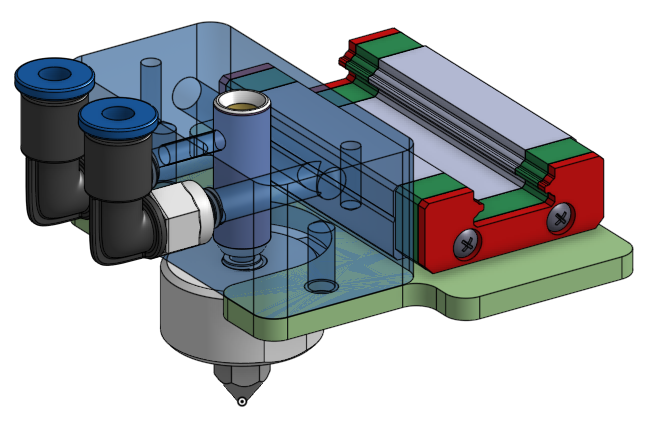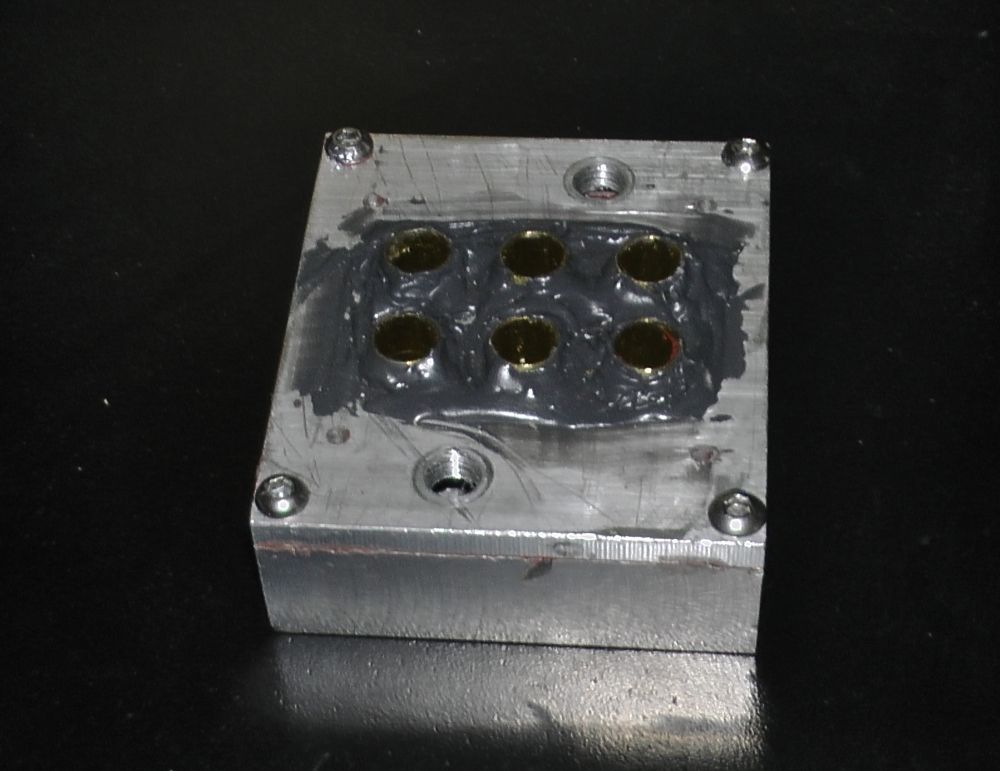My 6 input (5+1) mixing hot end
-
I think heat breaks without heatsinks would work too. This doesn't help Ian because E3D doesn't make a PTFE-lined heat break without heatsink.
-
I plan to order this heatbreak, which is very well done, because of using copper where good thermal conductivity is needed, and stainless steel where bad thermal conductivity is needed.
It is then very easy to integrate it in a bloc of aluminium, drilled with a few holes to have water circulation:

(the hole on the bottom-left needs to be closed by a screw+gasket)
The only problem is the price
 Especially when you need 6 of them! But they may give you some...
Especially when you need 6 of them! But they may give you some... -
@MrDui Funnily enough, my first cooling "tank" design use just that approach - but with simple tubes rather than the finned type. From other designs that I've looked at, the fins are not necessary when liquid cooling is used. But I had problems with leaks around the tubes. That was why I changed the lower part to one piece block with the tubes effectively milled out of a solid part.
For info, the liquid cooling system works just fine - I don't need to change it. The issue I have to resolve is filament leakage around the heat breaks where they are a press fit into a plate. The next design has screw threaded heat breaks which I hope will cure that problem.
-
@fma Yes, I've looked at the copper head and Slice engineering's liquid cooling designs too...(and every other "off the shelf" heat break that I can find).
My problem is that I have 6 inputs but only one output. With that type of heat break, the normal method of getting everything to seal is that the nozzle is tightened against the heat break. But I can't do that. So I need the heat break to have flats or a hexagonal section, so that it can be tightened against a flat plate. And it needs to be 4mm ID so that I can use a PTFE insert. So I'm having to make them. But they will look very similar to the heat breaks in the design you posted - just with flats or a hexagonal section so that they can be tightened.
Essentially, the cooling system and heat breaks worked well. It's just that I had filament leaks because press fitting the heat breaks into a flat plate didn't work well.
-
@MrDui For info, this was my first attempt at the simpler "tubular" design

Despite copious amounts of sealant, I still had leaks.
-
I don't know if they exist in such small size, but you may search for copper gaskets used on cars oil tanks: https://www.ebay.com/p/202950637
They are crushed during tightening, and handle high temperature.
-
Did you see this one? It can be tighten with a spanner, but I don't know how torque it can handle...
-
@fma said in My 6 input (5+1) mixing hot end:
Did you see this one? It can be tighten with a spanner, but I don't know how torque it can handle...
Yes I did. But it's "all metal" so only 2mm or so ID (internal diameter) and mixing hot ends need to have PTFE lined heat breaks.
-
Ah, sorry, I forgot that point...
-
@fma said in My 6 input (5+1) mixing hot end:
Ah, sorry, I forgot that point...
No worries - thanks for trying

-
I'm wondering how these heatbreaks are made: are they just brut force-fitted?
-
@fma said in My 6 input (5+1) mixing hot end:
I'm wondering how these heatbreaks are made: are they just brut force-fitted?
The Mosquito ones? I wish I knew. I've asked the question of Slice Engineering but they didn't answer - guess it's a trade secret.
To me, as an engineer, it's some sort of dark magic. The tubes are really, really, seriously, thin - very easy to bend or crush (I know from experience). So if they are press fit, then they must use a tool of some sort which is very good fit inside the tube to prevent it from crushing. Even then, I can't see how it can be a press fit. But the magic doesn't end there because they are stainless steel tubes, fitted inside a copper nut. Copper has a much higher coefficient of thermal expansion than stainless steel, so one would expect the tubes to come loose at high temperature but they don't. Maybe they use some sort of high temperature adhesive but there is no sign of any residue.
If I knew the answer, then it would reasonably easy to replicate using thin wall 4mm ID stainless tube which would take a PTFE liner, instead of the 2mm that Slice Engineering use.
-
Perhaps by using hot crimping?
-
@fma said in My 6 input (5+1) mixing hot end:
Perhaps by using hot crimping?
Perhaps. But the copper part of the heat breaks tend to change colour after they have been heated and there is no sign that has happened in the "as received" condition.
-
They may cool down the stainless steel tube with liquid nitrogen...
-
By way of an update if anyone is interested...........
https://www.youtube.com/watch?v=VQdoTJMsHGo
and
-
it is alive!!!
 AWESOME
AWESOME 
question, the acrylic "flow visualiser" with thermal probe - you made it or you purchased it ?
-
@arhi said in My 6 input (5+1) mixing hot end:
.......................
question, the acrylic "flow visualiser" with thermal probe - you made it or you purchased it ?You haven't been paying attention have you?
 https://www.youtube.com/watch?v=Hai_zqtcauQ&t=145s
https://www.youtube.com/watch?v=Hai_zqtcauQ&t=145sand
https://www.amazon.co.uk/gp/product/B078PFRG74/ref=ppx_yo_dt_b_asin_title_o08_s00?ie=UTF8&psc=1
-
@deckingman said in My 6 input (5+1) mixing hot end:
@arhi said in My 6 input (5+1) mixing hot end:
.......................
question, the acrylic "flow visualiser" with thermal probe - you made it or you purchased it ?You haven't been paying attention have you?
 https://www.youtube.com/watch?v=Hai_zqtcauQ&t=145s
https://www.youtube.com/watch?v=Hai_zqtcauQ&t=145sand
https://www.amazon.co.uk/gp/product/B078PFRG74/ref=ppx_yo_dt_b_asin_title_o08_s00?ie=UTF8&psc=1
I haven't watched it yet Ian but have you connected the Temp monitor to the Duet if not the Water-cooled PC guys do a sensor that is in fact a 10K thermistor which work quite well with the Duet.
-
@Dougal1957 said in My 6 input (5+1) mixing hot end:
@deckingman said in My 6 input (5+1) mixing hot end:
@arhi said in My 6 input (5+1) mixing hot end:
.......................
question, the acrylic "flow visualiser" with thermal probe - you made it or you purchased it ?You haven't been paying attention have you?
 https://www.youtube.com/watch?v=Hai_zqtcauQ&t=145s
https://www.youtube.com/watch?v=Hai_zqtcauQ&t=145sand
https://www.amazon.co.uk/gp/product/B078PFRG74/ref=ppx_yo_dt_b_asin_title_o08_s00?ie=UTF8&psc=1
I haven't watched it yet Ian but have you connected the Temp monitor to the Duet if not the Water-cooled PC guys do a sensor that is in fact a 10K thermistor which work quite well with the Duet.
You need to catch up too Doug
 Short answer (as you haven't been watching my videos), is no - that sensor just happened to be bundled with the flow meter so I bunged it on the printer because why not? I will be fitting a temperature sensor of some sort that I can connect to the Duet for monitoring purposes. No point in controlling the pump speed as it's almost silent, so I'm happy enough with the current arrangement which is to turn it thermostatically when the hot end temp>50 deg C. But It might be nice to take some action via a macro/conditional gcode if the coolant temperature exceeds some pre-determined value.
Short answer (as you haven't been watching my videos), is no - that sensor just happened to be bundled with the flow meter so I bunged it on the printer because why not? I will be fitting a temperature sensor of some sort that I can connect to the Duet for monitoring purposes. No point in controlling the pump speed as it's almost silent, so I'm happy enough with the current arrangement which is to turn it thermostatically when the hot end temp>50 deg C. But It might be nice to take some action via a macro/conditional gcode if the coolant temperature exceeds some pre-determined value.